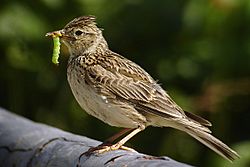Lark facts for kids
Quick facts for kids Larks |
|
|---|---|
 |
|
| Skylark (Alauda arvensis) | |
| Scientific classification | |
| Kingdom: | |
| Phylum: | |
| Class: | |
| Order: | |
| Suborder: | |
| Family: |
Alaudidae
Vigors, 1825
|
Larks are a family of songbirds called Alaudidae. These small to medium-sized birds live mainly in the Old World (Europe, Asia, and Africa). You can also find them in northern and eastern Australia.
Only one type of lark, the Shore lark, has traveled to North America. There, it is known as the Horned Lark. Larks live in many different places, but many species prefer dry areas.
Contents
What Makes Larks Special?
Larks are usually between 12 to 24 centimeters (about 5 to 9 inches) long. They weigh from 15 to 75 grams (about 0.5 to 2.6 ounces).
Like many birds that live on the ground, most larks have long claws on their back toes. These claws help them stay steady when they stand. Most larks have brown feathers with streaks, which helps them blend in with their surroundings. This natural camouflage keeps them safe, especially when they are on their nests.
What Do Larks Eat?
Larks eat both insects and seeds. Adult larks mostly eat seeds. However, all baby larks eat insects for at least the first week after they hatch. This gives them the nutrients they need to grow strong.
Many larks use their bills to dig for food. Some larks, like the thick-billed lark, have strong, heavy bills. These are perfect for cracking open tough seeds. Other larks have long, curved bills that are great for digging deep into the ground to find food.
Lark Feathers and Molting
Larks are special because they are the only passerine (songbird) that loses all its feathers in its very first molt. A molt is when a bird sheds its old feathers to grow new ones. This might happen because the first set of feathers on young larks isn't very strong. It also helps the parents, as feeding young larks a diet of seeds (which requires less work) is easier than constantly finding insects.
Larks look a bit like other ground birds, such as pipits. However, you can tell larks apart by looking at their legs. The lower part of a lark's leg, called the tarsus, has only one row of scales on the back. Most other songbirds have two rows of scales that meet at a sharp edge.
Lark Sounds and Homes
Amazing Calls and Songs
Larks are known for their beautiful and complex calls. Male larks often sing amazing songs while flying high in the sky. These songs are not just for fun; they help males protect their breeding areas and attract mates.
Because of their lovely songs, larks have appeared in many stories, poems, and songs. The Eurasian skylark is especially famous in northern Europe. The crested lark and calandra lark are well-known in southern Europe. Larks can even live near people, as long as the areas are not too busy.
Building Nests and Raising Young
Most larks build their nests on the ground. Their nests are usually shaped like cups and made from dry grass. Some species build more complex nests that are partly covered. A few larks that live in deserts build their nests low in bushes. This might help air circulate and keep the nest cool.
Lark eggs usually have speckles (small spots). The number of eggs in a nest can vary. Larks in very dry deserts might lay only two eggs. Larks in cooler, temperate areas might lay up to six eggs. The parents sit on the eggs to keep them warm for 11 to 16 days until they hatch.
Larks in Culture
Larks as Food Through History
For a long time, larks were considered a tasty and healthy food. People would eat them whole, bones and all. Larks could be cooked in many ways, like stewed, broiled, or used in meat pies. The tongues of larks were especially prized as a delicacy.
Today, it is much harder to find lark meat. This is because their natural homes have shrunk. However, you might still find lark dishes in some restaurants in Italy and other parts of southern Europe.
See also
 In Spanish: Aláudidos para niños
In Spanish: Aláudidos para niños


